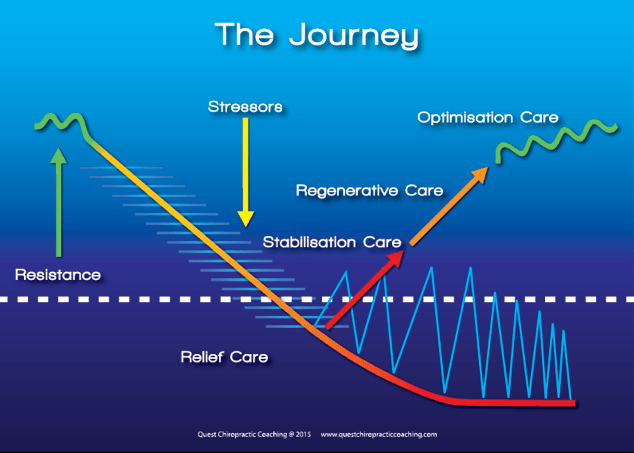Understanding Care choices
Many people come to us with an initial complaint, looking to find solutions to a problem.
Often this presentation in adults is back pain, headaches, neck pain, shoulder pain or knee pain. At our clinic we look after a lot of babies and children, so other presentations relevant to these age groups are common.
Regardless of any initial complaint, our role as Chiropractors is to detect subluxation and correct it. A subluxation can be present in the body without symptoms, or may be there before symptoms present, so symptoms are a poor judge of the need for Chiropractic care.
Understanding “phases of care” becomes essential to make the best decisions about how often to get a chiropractic check-up.
Here’s a brief overview of phases of care, allowing you to make the best choices based on your goals and values, and examination findings.
Understanding the “role of the Chiropractor” and “subluxations” are essential to understanding phases – so read these links also.
Phase 1:
People fall into phase 1 care when they have a number of subluxations in their spine, when they are more severe, or more long standing (Chronic).
The goal of care is to reduce the severity and number of subluxations, a bit like tapping a nail in – frequency and repetition are required. The amount of care is different for everyone. We call this phase “fixing care”.
Choose this care when you have active symptoms, a problem or condition to solve, or have never been to a Chiropractor before
Phase 2:
In phase 2 the “old” subluxations have been corrected, but due to them being there a while, they may relapse.
The goal of care is to check the spine to see whether the old subluxations are staying corrected, and to re-correct if required. Less frequent visits are required, and for most people this time frame takes about 6-10 weeks.
We call this phase “testing care” because we are testing to see if the subluxations are “holding” their correct movement.
Choose this care if you have completed phase one, are aiming to get more strong and stable internally, and want to prevent a previous symptom or condition coming back.
Phase 3:
In phase 3, the old subluxations are corrected, and we are looking for “new” subluxations.
New subluxations can occur at any time. The goal of this phase is to correct new subluxations as they arise, thus keeping the nervous system clear and connected.
Choose this care if you want to maintain your health at it’s current state, or continually improve your health to be at your best at all times.
We have two options for this type of care – the first is the Optimiser Program. This is for person who wants to be fully clear at all times, and is is focused on optimal health and performance
The second option is Maintenance Care. This is for the person who wants to maintain general function over time. Both are good options.
Call up care/self scheduled care:
Call up care is when a person call’s up for care based on a new symptoms or complaint, and manages their frequency of care based on these symptoms.
In this form of care its unlikely we fully correct subluxation – we simply reduce the symptoms associated with it.
Choose this care is you want short term symptom relief.
Spinal health, and nervous system health does not improve over time in this model. Naturally, we do not recommend this approach to health.
A better understanding results in better choices
The more we understand the above information, the more likely it is we make better decisions for ourselves and our families about how to manage our health.
By taking a health creation approach, we avoid adding to an already overburdened medical system.
Our role is to bring this information to you, and allow you to make choose the approach that suits you.




